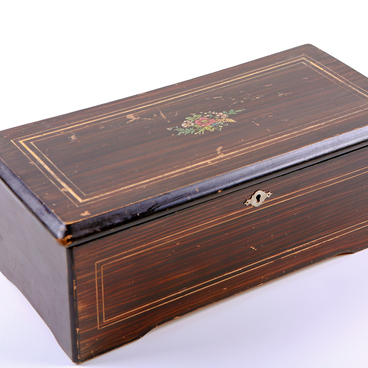The Kasimov Museum-Reserve houses the hatpin which belonged to the wife of the Kasimov artist Yefim Grushin. He was a friend of the composer Alexander Olenin, whose family estate was also in the Kasimov District.
Hatpins appeared in Europe in the Middle Ages. In the 15th century, they were used to attach a veil to hair. When hats came into fashion, this accessory began to be used for hats with wide brims. Girls also used them to attach big hats to hair. It helped the headdress to be held tightly on a head and not blown out by a strong wind, while horseback riding or in a street hustle.
The hatpin from the museum collection is a pointed metal rod of 23 centimeters. Its finial is decorated with glass stones. During the 19th–20th centuries, other materials were used for hatpins: metal, bone, mother-of-pearl, wood, as well as exotic turtle shell. The finials were decorated with rhinestones, gems or covered with enamel.
A safety-lock was sometimes attached to the pointed end of the pin, but most of the time, craftsmen used a standard design. The accessory was traumatic because of it: if the owner was riding a horse or her hat was touched by somebody, the pin could pierce or cut skin. Moreover, such an accessory was durable and did not bend, so women used it as a weapon of self-defense in dangerous situations.
At the beginning of the 20th century, Moscow and St. Petersburg issued a special order that said ladies wearing wide-brimmed hats were not allowed to use public transport so that not to injure passengers. All craftsmen were obliged to produce pins with tips. The order, however, did not help: the tip was often unscrewed and lost.
In Soviet times, big hats gradually went out of fashion, so pin production was practically shut down. Nowadays, you can find such antique hat accessories in museums or private collections.
Hatpins appeared in Europe in the Middle Ages. In the 15th century, they were used to attach a veil to hair. When hats came into fashion, this accessory began to be used for hats with wide brims. Girls also used them to attach big hats to hair. It helped the headdress to be held tightly on a head and not blown out by a strong wind, while horseback riding or in a street hustle.
The hatpin from the museum collection is a pointed metal rod of 23 centimeters. Its finial is decorated with glass stones. During the 19th–20th centuries, other materials were used for hatpins: metal, bone, mother-of-pearl, wood, as well as exotic turtle shell. The finials were decorated with rhinestones, gems or covered with enamel.
A safety-lock was sometimes attached to the pointed end of the pin, but most of the time, craftsmen used a standard design. The accessory was traumatic because of it: if the owner was riding a horse or her hat was touched by somebody, the pin could pierce or cut skin. Moreover, such an accessory was durable and did not bend, so women used it as a weapon of self-defense in dangerous situations.
At the beginning of the 20th century, Moscow and St. Petersburg issued a special order that said ladies wearing wide-brimmed hats were not allowed to use public transport so that not to injure passengers. All craftsmen were obliged to produce pins with tips. The order, however, did not help: the tip was often unscrewed and lost.
In Soviet times, big hats gradually went out of fashion, so pin production was practically shut down. Nowadays, you can find such antique hat accessories in museums or private collections.

